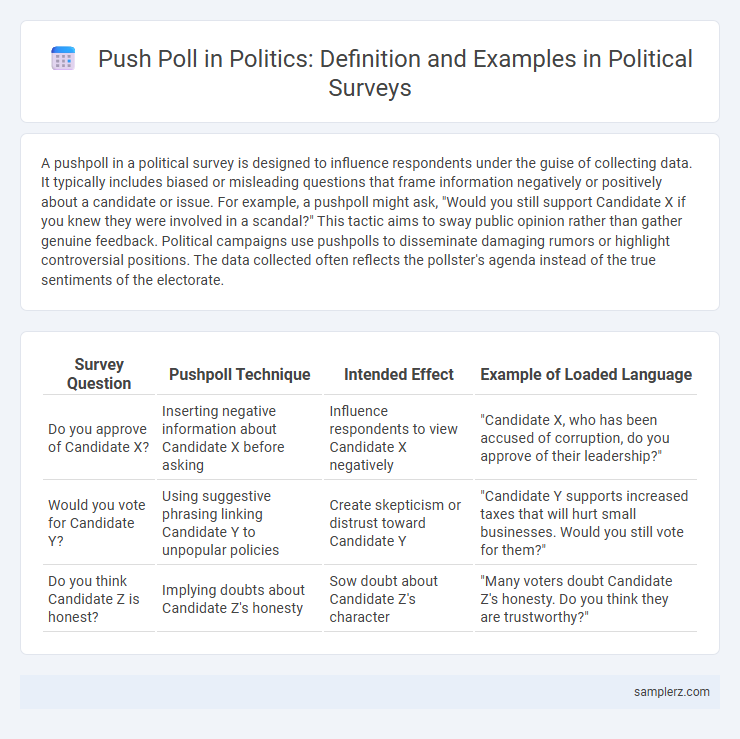A pushpoll in a political survey is designed to influence respondents under the guise of collecting data. It typically includes biased or misleading questions that frame information negatively or positively about a candidate or issue. For example, a pushpoll might ask, "Would you still support Candidate X if you knew they were involved in a scandal?" This tactic aims to sway public opinion rather than gather genuine feedback. Political campaigns use pushpolls to disseminate damaging rumors or highlight controversial positions. The data collected often reflects the pollster's agenda instead of the true sentiments of the electorate.
Table of Comparison
| Survey Question | Pushpoll Technique | Intended Effect | Example of Loaded Language |
|---|---|---|---|
| Do you approve of Candidate X? | Inserting negative information about Candidate X before asking | Influence respondents to view Candidate X negatively | "Candidate X, who has been accused of corruption, do you approve of their leadership?" |
| Would you vote for Candidate Y? | Using suggestive phrasing linking Candidate Y to unpopular policies | Create skepticism or distrust toward Candidate Y | "Candidate Y supports increased taxes that will hurt small businesses. Would you still vote for them?" |
| Do you think Candidate Z is honest? | Implying doubts about Candidate Z's honesty | Sow doubt about Candidate Z's character | "Many voters doubt Candidate Z's honesty. Do you think they are trustworthy?" |
Understanding Push Polls in Political Surveys
Push polls manipulate voter opinions by posing biased questions that suggest negative information about a candidate, often framed as a survey. These calls or surveys typically include leading queries designed to implant damaging ideas rather than gather genuine data, skewing public perception. Recognizing phrases like "Are you aware of the scandal involving Candidate X?" helps identify push polls intended to influence election outcomes covertly.
Key Characteristics of Push Polls
Push polls are characterized by leading questions that manipulate respondents' opinions under the guise of conducting a survey. They often incorporate emotionally charged or misleading information to influence voter perceptions rather than gather unbiased data. The primary goal is to sway public opinion by spreading negative or false messages about a political candidate or issue.
Real-World Examples of Push Polls in Politics
Push polls in politics often deploy misleading questions to sway voter opinions, such as during the 2004 U.S. presidential election when voters were asked if they would be less likely to vote for John Kerry due to false claims about his military service. In the 2016 Brexit referendum, push polls circulated misinformation suggesting that Turkey was about to join the EU, aiming to influence public perception against remaining. These tactics exploit survey formats to spread negative narratives under the guise of legitimate polling data, distorting the democratic process.
Notorious Political Push Poll Case Studies
One notorious political push poll case occurred during the 2000 U.S. presidential election, where voters in South Carolina received misleading calls suggesting Al Gore supported high taxes, aiming to manipulate opinion rather than gather data. Another example is the 2012 Michigan Senate race, where push polls falsely linked candidate Gary Peters to controversial policies, damaging his public image. These cases illustrate how push polls exploit survey techniques to spread disinformation and influence voter behavior under the guise of legitimate polling.
Push Poll vs. Legitimate Survey: Key Differences
Push polls manipulate responses by framing questions with biased or misleading information, often designed to sway opinions rather than collect genuine data. Legitimate surveys use neutral, clearly worded questions to gather accurate and unbiased insights from respondents. The key difference lies in intent and methodology: push polls aim to influence voter perception, while legitimate surveys prioritize objective measurement of public opinion.
How Push Polls Influence Voter Opinion
Push polls manipulate voter opinion by presenting biased or misleading information disguised as survey questions, often attacking a candidate's character or record. These tactics exploit cognitive biases, leading respondents to internalize negative associations that can alter their perceptions and voting behavior. Research shows push polls effectively shift public opinion by framing issues in a prejudicial manner under the guise of legitimate polling.
Ethical Concerns Surrounding Push Polls
Push polls in political surveys manipulate voter opinions by presenting biased or misleading questions, often masquerading as legitimate polling. Ethical concerns arise because these tactics distort public perception and undermine informed decision-making by spreading negative or false information under the guise of research. Such practices violate principles of honesty and transparency, eroding trust in the democratic process.
Legal Responses to Push Polls in Campaigns
Legal responses to push polls in political campaigns vary across jurisdictions, often addressing the deceptive nature of these surveys by imposing stricter regulations on disclosure and question framing. Several states in the U.S., such as California and New York, have enacted laws requiring clear identification of the sponsor and purpose to prevent misinformation. Courts have also upheld penalties against campaigns that use push polls to spread false information, emphasizing the protection of voter integrity and election fairness.
Detecting Push Polls in Pre-Election Surveys
Detecting push polls in pre-election surveys requires analyzing question phrasing for bias or loaded language intended to influence respondents rather than collect genuine opinions. Survey researchers examine response patterns for inconsistencies or unusually negative reactions toward specific candidates, which may indicate manipulative techniques. Statistical methods such as frequency analysis and cross-tabulation help identify responses skewed by leading or suggestive questions designed to sway voter perceptions.
Impact of Push Polls on Public Perception and Outcomes
Push polls use manipulative questions to influence voter opinions, often spreading negative information about opponents under the guise of a survey. These tactics distort public perception by creating biased narratives and can significantly impact election outcomes by swaying undecided voters. Research shows that push polls contribute to misinformation, reducing trust in the political process and increasing polarization among the electorate.

example of pushpoll in survey Infographic
 samplerz.com
samplerz.com